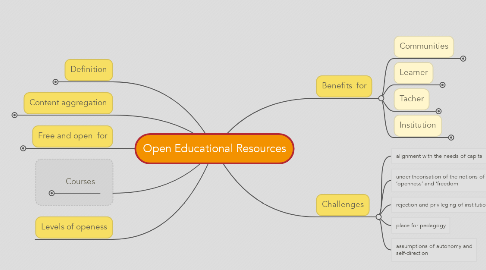
1. Definition
1.1. OER Handbook
1.2. Wikipedia
1.3. Wikiversity
1.4. WikiEducator
2. Content aggregation
2.1. http://www.techmeme.com/
2.2. http://www.reddit.com/
2.3. http://digg.com/
2.4. http://www.techmeme.com/
2.5. http://hubpages.com/topics/all/1
3. Free and open for
3.1. teaching
3.2. research
3.3. learning
3.4. sharing, using, and reusing knowledge
3.5. other purposes
4. Courses
4.1. Webcast Berkeley
4.1.1. American Studies C132B, 001 - Fall 2014
4.1.2. American Studies C132B, 001 - Fall 2014
4.1.3. Astronomy C12, 001 - Fall 2014
4.1.4. Biology 1AL, 001 - Fall 2014
4.1.5. Chemistry 3B, 002 - Fall 2014
4.1.6. Cognitive Science C102, 001 - Fall 2014
4.1.7. Computer Science 10, 001 - Fall 2014
4.2. Curriki
4.2.1. Arts
4.2.2. Career & Technical Education Resources
4.2.3. Education
4.2.4. Educational Technology
4.2.5. Health
4.3. UNESCO
4.4. OpenStax College
4.4.1. College Physics
4.4.2. Sociology
4.4.3. Concepts of Biology
4.4.4. Anatomy and Physiology
4.4.5. Statistics
4.5. Academic Earth
4.5.1. Biology
4.5.2. Marketing
4.5.3. Psychology
4.5.4. Economics
4.5.5. Computer Science
4.5.6. Art History
5. Benefits for
5.1. Communities
5.1.1. Enables cross-disciplinary collaboration.
5.1.2. Facilitates subject-based collaboration.
5.1.3. Strengthens relationships between educational establishments and other organisations (such as government organisations, charitable trusts, businesses and employers).
5.1.4. Enhances discussion and debate about academic ideas
5.1.5. Greater efficiency through producing generic materials suitable for a variety of courses or disciplines.
5.1.6. Promotes a fresh look at curriculum and course development.
5.1.7. Enables new kinds of collaboration
5.1.8. Provides opportunities for profile raising
5.1.9. Allows educational institutions to collaborate more easily with each other.
5.2. Learner
5.2.1. A clearer idea of what it's like to study within a particular institution, subject area or course prior to application.
5.2.2. Access to supplementary resources to support study skills.
5.2.3. Free access to educational resources without being required to enrol in an institution.
5.2.4. A curriculum which is integrated into real life experience
5.2.5. The ability to benefit from varied perspectives on, and approaches to, a single subject.
5.2.6. Resources can be accessed in a variety of settings - useful for non-traditional and work-based learners.
5.2.7. Free-of-charge access to a wide range of educational resources worldwide.
5.3. Tacher
5.3.1. Improved public engagement
5.3.2. Widening access and participation.
5.3.3. Social responsibility in line with the academic traditions of sharing knowledge.
5.3.4. More opportunities to collaborate within and beyond the institution.
5.3.5. Preserving knowledge in disciplines where resources are not widely available.
5.3.6. Improved intellectual property management.
5.3.7. New opportunities for staff development.
5.3.8. Extending the institution’s reach internationally.
5.3.9. Marketing and reputation building through showcasing the work of the institution.
5.4. Institution
5.4.1. Extending the institution’s reach internationally
5.4.2. Social responsibility in line with the academic traditions of sharing knowledge.
5.4.3. Improved public engagement
5.4.4. Marketing and reputation building through showcasing the work of the institution.
5.4.5. Widening access and participation.
5.4.6. New opportunities for staff development.
5.4.7. Preserving knowledge in disciplines where resources are not widely available.
5.4.8. More opportunities to collaborate within and beyond the institution.
5.4.9. Improved intellectual property management.

